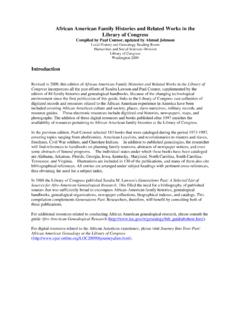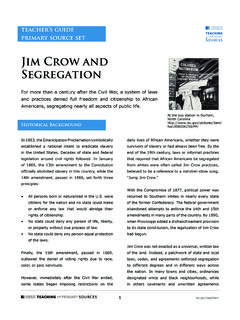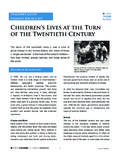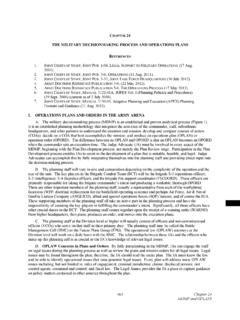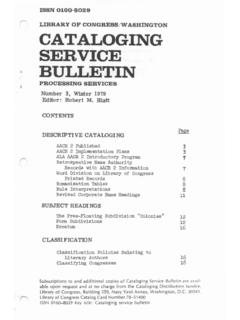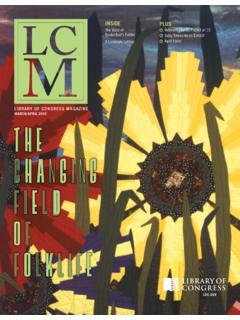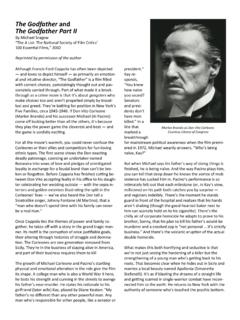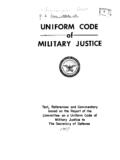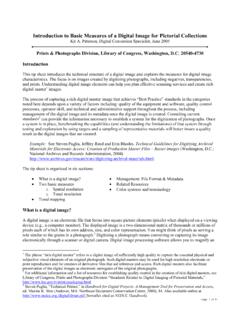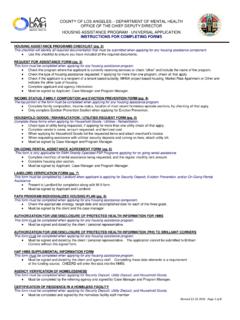Transcription of “Brilliant Corners”--Thelonious Monk (1957)
1 brilliant corners -- thelonious monk (1957) Added to the National Registry: 2003 Essay by Robin D. G. Kelley (guest post)* brilliant Corner album cover thelonious monk s brilliant corners is arguably not only his most critically-acclaimed LP but it marked a major turning point in his career. With the release of brilliant corners , the 39 year-old pianist/composer finally achieved the recognition that had eluded him for nearly two decades. Critic John S. Wilson of the New York Times declared it proof that this man who was once viewed as an inscrutable eccentric is slowly developing into one of the most valid jazz voices of this decade. The record garnered rave reviews from the jazz press around the world, including Metronome, Japan s Swing Journal (which called it a masterpiece ), and Down Beat, which listed brilliant corners as the most critically-acclaimed album of 1957. monk had been on the scene since 1939, becoming the house pianist at Minton s in Harlem, a sideman for Coleman Hawkins, and an innovative recording artist with Blue Note and Prestige Records.
2 However, because monk diverged from the dominant idioms of bebop and post-bop jazz, he endured harsh, ill-informed criticism and limited opportunities. Then in August of 1951, he was falsely arrested for narcotics possession and the police revoked his cabaret card a license required to work in New York clubs. He survived by playing neighborhood clubs in Brooklyn and the Bronx, sporadic concerts, out-of-town gigs, and occasional record dates. In 1955, he signed with a new label, Riverside. His producer, Orrin Keepnews, decided to re-introduce monk to jazz listeners in a trio setting by dedicating his first two LPs to the music of Duke Ellington and to jazz standards. brilliant corners , the much-anticipated third album, was to feature his original compositions played by a larger ensemble. For the session monk chose alto saxophonist Ernie Henry, Sonny Rollins on tenor, drummer Max Roach and bassist Oscar Pettiford, who had played on monk s two previous Riverside sessions.
3 The brilliant corners album took three sessions and two months to complete. On the first date, October 9th, they recorded two new compositions both dedicated to monk s friend and jazz patron, the Baroness Pannonica de Koenigswarter or Nica, whose home became the band s primary rehearsal space. Pannonica, a gorgeous tune somewhere between a ballad and a medium-tempo foxtrot, opens with monk playing the melody on a celeste he spotted in the studio. He positioned it perpendicular to the piano, which allowed him to play it with his right hand while playing chords on the piano with his left, resulting in a jarring juxtaposition of sound. They also recorded a blues referencing Nica s ceaseless troubles with the management at the Bolivar Hotel with the treacherous title Ba-lue Bolivar Ba-Lues-Are. Exceeding 13 minutes and with slightly unconventional changes in bars 6 8, the recording captures outstanding solos by Henry, monk , and Rollins.
4 Henry s crying, slurred, loping notes is arguably his best moment on record. monk s dynamic accompaniment is as inventive as his solo, which injects humor into bluesy wails of Henry and Rollins. When the band returned to Reeves Studio six days later, presumably to complete the LP, they managed to spend the entire four hours on just one song: brilliant corners . Full of wide intervallic leaps, the first 16 bars of the melody and the harmonic movement are quite literally shaped like a circle while the bridge retains monk s more characteristic descending chromatic chord progressions. The entire first chorus is played as a slow dirge and then repeated in double-time. The solos follow the same pattern. But the biggest rhythmic challenge was the song s 22-bar structure: monk wrote a seven-bar bridge and he removed a measure from the last A-section, making it seven bars as well. For musicians used to the standard 32-bar song form, brilliant corners threw them for a loop.
5 monk s decision to not share the music with the band did not help matters. Like Duke Ellington, he believed that the best way to master a song was to learn it by ear. Despite several days of rehearsals, only Rollins had been able to master the unusual 22-bar structure, the difficult intervals, and the shifting tempos by the time they recorded brilliant corners . Roach and Pettiford reportedly struggled the most, leading Pettiford to disparage monk s composing. You don t have enough bars, he said at one point. Pettiford became so angry that, on one take, he only pretended to play, strumming his fingers over the strings without producing a sound. When the session finally ended, Keepnews had 25 incomplete takes that he had to knit together in order to create a full version. The results are stunning. Upon listening, it becomes clear that the band had less difficulty improvising than playing the theme correctly in unison. Sonny Rollins delivers a near-perfect solo by abiding monk s advice to use the melody as the basis for improvisation.
6 monk , not surprisingly, produces a brilliant solo that might be best described as a variation on the theme. Ernie Henry s whining long-tones work beautifully against the changes, and despite Roach s complaints, his judicious choices prove why monk had hired him in the first place. It took two months before monk could complete the LP, and he had no choice but to return with a slightly different band. Rollins and Roach s road schedule was the source of the delay, but in the interim, Ernie Henry quit to join Dizzy Gillespie s band and Oscar Pettiford refused to come back. Trumpeter Clark Terry replaced Henry and a phenomenal young bassist named Paul Chambers substituted for Pettiford. In the short period allotted them on December 7th, the band delivered a formidable rendition of Bemsha Swing, a Caribbean-inflected melody monk had co-written six years earlier with his friend, Barbadian-born drummer Denzil Best. Roach positioned his kit adjacent to a tympani drum, which he used to great effect, creating sudden bursts of rolling thunder.
7 After completing a solid take of Bemsha Swing, they had about 20 minutes to vacate the studio and were still five minutes short of a completed album. monk saved the session with a five and a half minute solo version of Harry Barris and Gordon Clifford s I Surrender Dear. brilliant corners s release and the critical acclaim it received coincided with the return of monk s cabaret card and his historic opening at the Five Spot Caf with John Coltrane on tenor saxophone. An old East Village bar turned artist hang out and jazz club, monk s six-month stint put the Five Spot on the American cultural map and launched the pianist on a path to international fame. Although monk s long hiatus from Manhattan s club scene partly explains why long lines gathered outside of the tiny club to see him, the success of brilliant corners proved to be a major catalyst for his sudden popularity. By 1958, thelonious monk was chosen Best Pianist in the Down Beat International Critics Poll, beating out Erroll Garner, Oscar Peterson, and Earl Hines.
8 Robin D. G. Kelley is the Gary B. Nash Professor of History at UCLA and the author of thelonious monk : The Life and Times of an American Original (Free Press, 2009) and Africa Speaks, America Answers: Modern Jazz in Revolutionary Times (Harvard University Press, 2012). *The views expressed in this essay are those of the author and do not necessarily represent the views of the Library of Congress.
